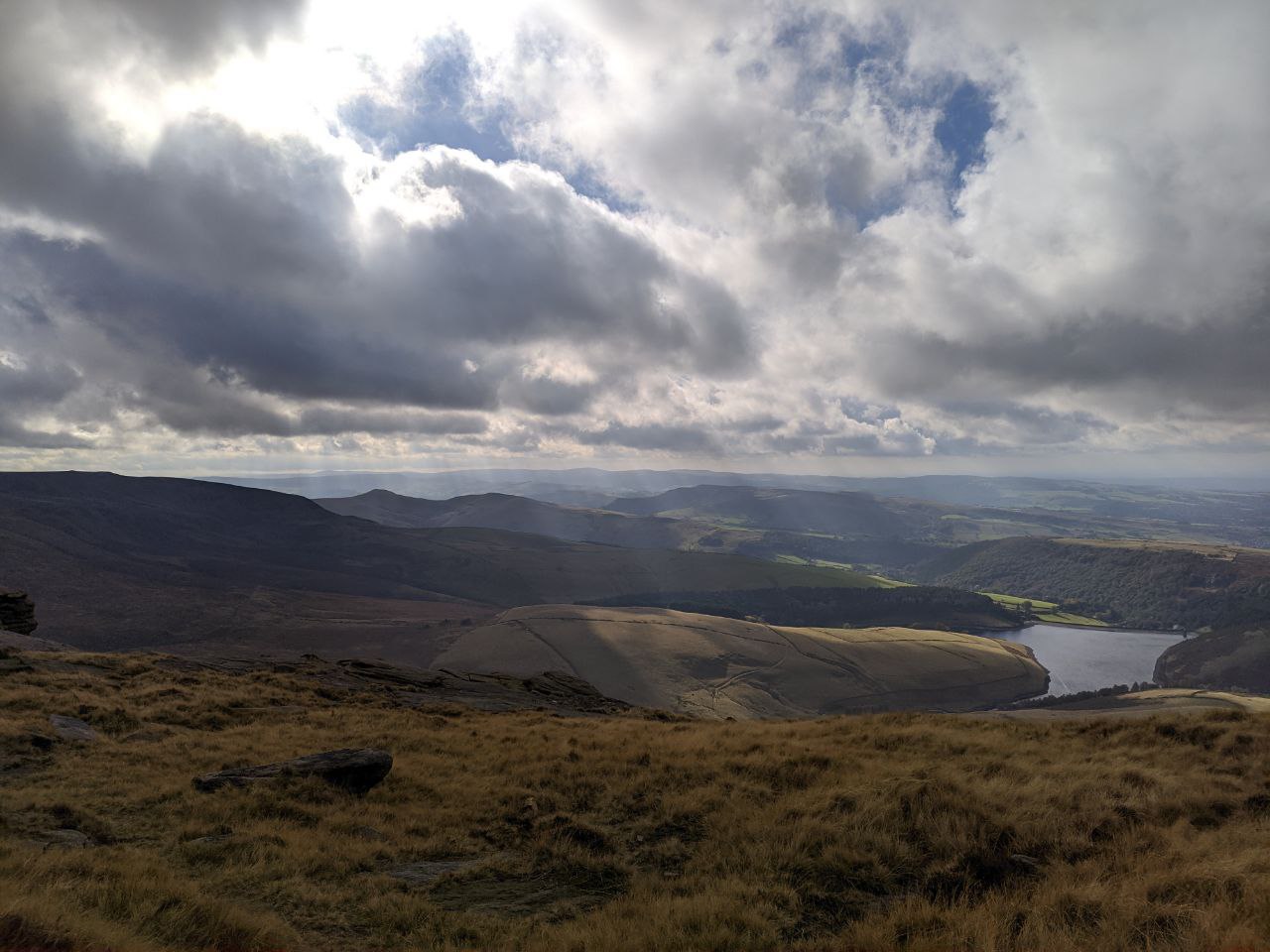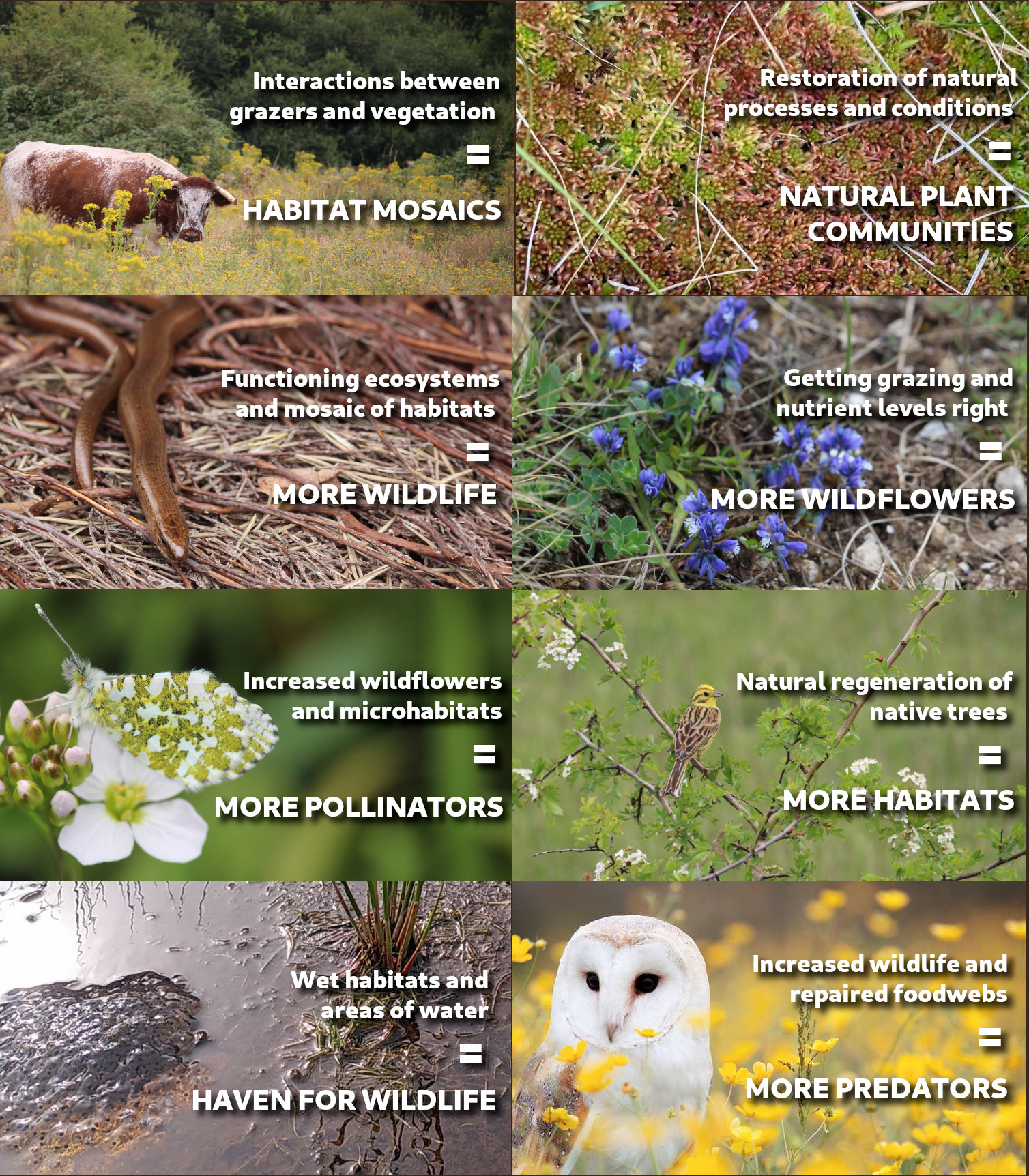Why are we doing this?
Humanity is facing an existential threat. The twin crises of climate breakdown and biodiversity collapse endanger our health, wealth, happiness, and even survival. Extinction rates are approximately 1,000 times higher than background rates [1], and we are arguably in the midst of a sixth mass extinction [2].
Against this backdrop, Britain is one of the most nature-depleted countries in the world:
- 56% of our species in decline between 1970-2013 [3]
- 19% decline in abundance across all our species, on average [4]
- 54% of flowering plant species have declining distributions [4]
- 16% of our species threatened with extinction [4]
- Reducing climate change through the way we manage our land is still insufficient [5].
"Between 1970 and 2013, 56% of species declined, with 40% showing strong or moderate declines"
-- State of Nature Report 2016
"16% (almost 1,500 species) are now threatened with extinction"
-- State of Nature Report 2023
"Time is running out to implement measures that will effect change in species abundance by 2030 and achieve wider outcomes"
-- The OEP Progress Report
Climate breakdown and biodiversity collapse are not only disastrous for wildlife. The Dasgupta Review in 2021 showed that biodiversity underpins our entire global economy: our health, wealth, and wellbeing depend on it [6]. It also found that halting and reversing these trends requires action now, and this will be vastly less costly than delay. Likewise, the Stern Review found that climate change represents a serious global threat to humanity, which could cause suffering to hundreds of millions of people [7]. It also showed that the economic costs of not acting are far greater than those of acting. The 2023 Intergovernmental Panel on Climate Change (IPCC) synthesis report showed that climate breakdown was already adversely affecting millions, while a recent paper found that ultimately a billion people may be killed [8].
"Our economies, livelihoods and well-being all depend on our most precious asset: Nature"
-- The Dasgupta Review
"The costs of stabilising the climate are significant but manageable; delay would be dangerous and much more costly"
-- The Stern Review
"Approximately 3.3 to 3.6 billion people live in contexts that are highly vulnerable to climate change"
-- IPCC 2021
"If warming reaches or exceeds 2 °C this century, mainly richer humans will be responsible for killing roughly 1 billion mainly poorer humans"
-- Pearce and Parncutt, 2023
What will we buy?
Wild•Ling will purchase and restore a piece of land for nature, with an emphasis on ecosystem function and biodiversity. The land we will purchase will most likely be in the uplands of the spectacular Peak District, which lies in the North of England, between Manchester and Sheffield. We prefer to purchase in the uplands because these areas are of less value to farming, due to harsher weather and thinner soils. This means two things: the land is cheaper, so we have greater buying power, but also we are not taking valuable land out of food production. In fact, upland farming is almost always loss-making, and is propped up by substantial government subsidies. There’s a strong argument for our uplands being of more value to society when they are managed for ecosystem services rather than farming, such as carbon sequestration, flood prevention, air and water quality improvements, and beneficial biodiversity.

Though conditions can be tough, the ecology of uplands is special. The Peak District holds a range of habitats, from acidic peatlands, to gritstone edges, to river valleys, to limestone dales. The habitats and species are influenced by many factors, such as the geology and soils, elevation, slope, aspect, and management. You can find blanket bog, upland calcareous grassland, woodland, and even montane habitats, each with their own characteristic and special species.
Though the Peak District is beautiful, and there are many important habitats there, much of it has been damaged by poor management
How will we manage the land?
As far as is possible on a small site, we will use a process-led approach. Associated with rewilding theory, process-led means focusing on restoring natural processes rather than on particular species or habitats, which drives a more natural, dynamic, and resilient ecosystem. These natural processes can be things like pollination, grazing, soil formation, and hydrology. Process-led restoration can be seen as allowing nature to take the reins and self-determine what is appropriate for that site. This is in contrast to high-intervention or species-led conservation, which is target-focused and often aims to keep a site in stasis. Though rewilding is often associated with ambitious species reintroductions, at its heart it is about restoring the processes that create, drive, and protect healthy ecosystems. Find out more about rewilding
Once we have purchased our piece of land, we will do the following:
- Safeguard the land for nature into the future. Depending on what is most appropriate, this will take the form of a conservation covenant, or "asset locking" the land into a charity or Community Interest Company (CIC). Whichever we choose, we will aim to ensure the land is dedicated to nature in perpetuity. Find out more about conservation covenants.
- Carry out site surveys and baseline monitoring. This will tell us about our site: its soils, habitats, species, and processes. It will help us understand what “ought” to be there, and what habitats and species are likely to establish once processes are restored. But monitoring doesn’t stop there! Our initial surveys will form our baseline, and regular resurveys will allow us to see what changes are taking place, and what impact our management is having.
- Create a site management plan. Process-led conservation does not mean land abandonment, and even low intervention sites need well-planned management. It’s generally understood that the smaller the site, the more natural processes will need to be mimicked by human management, and sometimes processes need a helping hand to get started. And there are always other considerations with being a responsible land manager: fencing and access, human and wildlife safety, biosecurity, etc.
- Keep raising funds. Managing a site isn’t free. We will consider funding for nature schemes, such as Biodiversity Net Gain to keep funding our project. Any money raised from schemes will go into nature recovery - either managing this site, or even towards buying more land. None of us will make a personal profit.
- Think about people. Connecting people with nature is important. Those who spend time in nature also take care of it more, and there is endless research showing how important nature is to our health and wellbeing. We will consider what the options are for site access, outreach, or education, depending on what is appropriate to the site.
What benefits can we expect to see?
Once ecosystems are functioning properly, they support more and varied wildlife, offer more ecosystem services (such as carbon sequestration and flood prevention), and are more resilient to shocks and change, like climate breakdown. Because that is hard to envisage, here are some of the things we may expect to see on our site:

Can we do this?
Wild•Ling is a conservation project led by conservation professionals, who are committed to buying and restoring land for nature. Our name, Wild•Ling, refers to the alternative name for common heather, a reference to the Peak District's high moorlands. We are all passionate about the natural world - and frightened about the environmental crises we face. We count two ecologists in our ranks, who work in the conservation sector. Between us, we have the following experience and skillsets:
- Site management for nature, including creating site management plans, species recovery plans (including for woodlark, harvest mice, snipe, purple emperor butterflies, hedgehogs, silver-studded blue butterflies and scarce blue-tailed damselflies), visitor management.
- Practical land management skills such as woodland and tree management, meadow and lowland heathland management, hedgerow creation and management, scrub management, as well as managing SANGs, SSSI, SPAs, Local Nature Reserves and Local Wildlife Sites. We've also worked to create new climate change-resilient native woodlands, increased lowland heath coverage, and created/converted lowland hay meadows.
- Field survey and monitoring, including SSSI condition assessments, botanical surveys, tree surveys, bird surveys, herptile surveys, small mammal trapping and other mammal surveys, butterfly surveys
- Funding application experience, including Section 106 funding and assistance with BNG process, as well as working alongside several stakeholders including The Crown Estate, The Wildlife Trust, Thames Water and The Land Trust.
- Outreach and teaching experience in the conservation and climate change sector.
- Degrees in ecology and conservation, and in UK Ecology, as well as practical land management certifications.
Find out more on the Who We Are page
Once we have bought our patch of land, we will join the network of inspiring rewilding projects springing up around the world, such as Rewilding Britain’s Rewilding Network, and Derbyshire Wildlife Trust’s Wild Peak network. These nationwide communities will support and inform our work, and help us see where our project fits in at the landscape-scale. To this end, we will also seek to work with other local land managers who have an interest in conservation. This will ensure we have a coherent vision that offers the best for nature across many sites. We know we are always more powerful when we work together.
